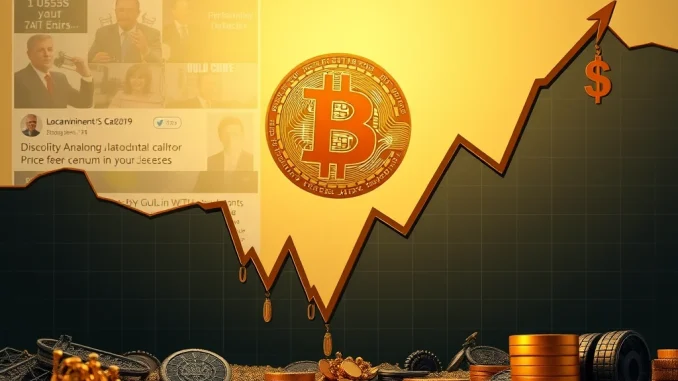
Hold onto your hats, crypto enthusiasts! The market rollercoaster continues its wild ride, and Bitcoin, the king of crypto, is feeling the turbulence. Just when you thought things were stabilizing, news of fresh U.S. tariffs sent shockwaves, causing Bitcoin to take a significant nosedive. But how deep was the plunge, and is this just a temporary dip or a sign of deeper market shifts? Let’s dive into the numbers and unpack what’s happening with Bitcoin and the broader crypto landscape.
Why Did Bitcoin Take a Hit After the Tariff Announcement?
According to CryptoQuant, a leading blockchain analytics firm, Bitcoin (BTC) experienced a sharp 16.7% drop following the announcement of new tariffs by the U.S. administration. This move, intended to reshape international trade, had an immediate ripple effect across various markets, and crypto was no exception. But why did tariffs specifically impact Bitcoin? Here’s a breakdown:
- Increased Economic Uncertainty: Tariffs often signal trade tensions and potential economic slowdowns. This uncertainty makes investors jittery, prompting them to move away from perceived riskier assets like cryptocurrencies.
- Dollar Strength: Tariffs can sometimes lead to a stronger U.S. dollar. Historically, a stronger dollar can negatively correlate with Bitcoin prices, as Bitcoin is often seen as an alternative to fiat currencies, including the dollar.
- Market Sentiment: News of tariffs can create a negative market sentiment overall. Even if the direct impact on crypto is debatable, a general ‘risk-off’ mood can lead to selling pressure on assets like Bitcoin.
It’s important to remember that the global market is interconnected. Events in traditional finance often spill over into the crypto world, and tariff announcements are no exception.
Tariff Tussle: Bitcoin vs. Traditional Assets – Who Weathered the Storm Better?
The real eye-opener is how Bitcoin performed compared to traditional assets during this tariff-induced market wobble. While Bitcoin tumbled 16.7%, let’s see how other asset classes fared:
| Asset | Performance Post-Tariff Announcement |
|---|---|
| Gold | +12.9% |
| S&P 500 | -13.8% |
| Nasdaq | -17.5% |
| Oil | Similar to Nasdaq performance |
| Bitcoin (BTC) | -16.7% |
As you can see, gold emerged as a clear winner, acting as a classic safe-haven asset and gaining nearly 13%. The S&P 500 also experienced a significant dip, but less severe than Bitcoin’s. Interestingly, Bitcoin’s performance is sandwiched between the Nasdaq and oil, indicating it’s not quite behaving like the uncorrelated, safe-haven asset some proponents believe it to be. This comparison raises a critical question: Is Bitcoin truly diversifying your portfolio during times of economic uncertainty?
Is Bitcoin Losing Its Safe-Haven Asset Narrative?
For years, a key argument for Bitcoin’s long-term value has been its potential as a safe-haven asset – a store of value that holds up or even appreciates during economic downturns or geopolitical instability. The recent market reaction throws a wrench into this narrative.
While Bitcoin did recover from an even deeper initial dip of -26.7%, its current position suggests a more nuanced reality. It’s rebounding, but not with the resilience expected of a true safe haven. Factors contributing to this include:
- Market Maturity (or Lack Thereof): The crypto market, while growing, is still relatively young and more volatile than established markets like gold or the S&P 500. This inherent volatility can overshadow any safe-haven properties.
- Speculative Nature: Bitcoin still carries a significant degree of speculative investment. Market sentiment and hype can drive price swings more dramatically than fundamental economic factors in the short term.
- Correlation with Risk Assets: Increasingly, Bitcoin’s price movements have shown correlation with riskier assets like tech stocks. This correlation diminishes its effectiveness as a portfolio diversifier during risk-off periods.
The data suggests that while Bitcoin might possess some characteristics of a store of value, it’s not yet consistently acting as a reliable safe-haven asset in the face of global economic uncertainties like tariff announcements.
Market Recovery: Bitcoin’s Partial Rebound – What Does It Mean?
It’s not all doom and gloom for Bitcoin. The fact that it has shown a market recovery from its deepest dip is noteworthy. This partial rebound indicates underlying strength and continued investor interest in the asset. However, the pace and extent of this recovery are crucial.
Bitcoin’s current position, nestled between the Nasdaq and oil in terms of recovery, suggests a moderate rebound, not a V-shaped surge to previous highs. This could mean a few things:
- Cautious Optimism: Investors are cautiously returning to Bitcoin after the initial shock, but not with full conviction. The tariff situation and broader economic outlook are likely still weighing on sentiment.
- Bottom Fishing: Some investors might be seeing the dip as a buying opportunity, contributing to the partial recovery.
- Market Adjustment: The market is adjusting to the new information (tariffs) and recalibrating Bitcoin’s price accordingly.
The key takeaway here is that while Bitcoin is showing resilience, the market recovery is not yet a full-blown bullish signal. It’s more of a tempered response, reflecting the ongoing uncertainties.
Broader Crypto Market Implications: Beyond Bitcoin’s Price Swings
Bitcoin’s price action often sets the tone for the wider crypto market. Its 16.7% fall and subsequent partial recovery likely mirrored trends across various altcoins. This event underscores a few important considerations for the broader crypto space:
- Volatility is Inherent: The crypto market remains highly volatile. External events, like tariff announcements, can trigger significant price swings, impacting all cryptocurrencies to varying degrees.
- Risk Management is Crucial: Investors in crypto need to be prepared for volatility and implement robust risk management strategies. Diversification, position sizing, and understanding market dynamics are essential.
- Maturing Market, Evolving Narratives: As the crypto market matures, narratives around individual cryptocurrencies, including Bitcoin’s safe-haven status, will continue to be tested and refined by real-world market events.
The tariff-induced dip serves as a valuable lesson about the interconnectedness of global markets and the evolving role of cryptocurrencies within the broader financial ecosystem.
In Conclusion: Navigating the Bitcoin Landscape in a World of Tariffs
The recent Bitcoin price drop following the U.S. tariff announcement is a stark reminder of the crypto market’s sensitivity to global economic events. While Bitcoin has shown a partial recovery, its underperformance compared to traditional safe havens like gold challenges the simple narrative of BTC as an infallible store of value in times of uncertainty.
For investors, this episode highlights the importance of:
- Staying Informed: Keeping abreast of global economic news and understanding how it might impact the crypto market.
- Realistic Expectations: Acknowledging that Bitcoin, while promising, is still a volatile asset and may not always behave as a safe haven.
- Diversification: Considering a diversified investment portfolio that includes a mix of asset classes to mitigate risk.
The crypto journey is full of twists and turns. Understanding market reactions to events like tariff announcements is crucial for navigating this exciting, yet often unpredictable, landscape. Stay informed, stay cautious, and keep learning!



